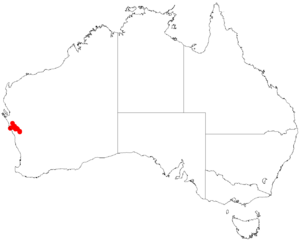Prostanthera scutata facts for kids
Quick facts for kids Prostanthera scutata |
|
|---|---|
| Conservation status | |
| Scientific classification | |
| Genus: |
Prostanthera
|
| Species: |
scutata
|
 |
|
| Occurrence data from AVH | |
Prostanthera scutata is a type of flowering plant found only in Western Australia. It belongs to the Lamiaceae family, which includes mint plants. This plant is a small, upright shrub with fuzzy branches. It has oval-shaped leaves and pretty pale blue or light purple flowers.
Contents
What Does Prostanthera scutata Look Like?
Prostanthera scutata is a small, upright, and bushy plant. It usually grows to be about 20 to 30 centimeters (8 to 12 inches) tall. Its branches are covered in thick, soft hairs.
The leaves of this plant are shaped like an oval, or a narrow oval. They are quite small, ranging from 1.5 to 11 millimeters long and 1 to 6 millimeters wide. The leaves are attached to the stem by a tiny stalk called a petiole, which is only about 0.5 to 2 millimeters long.
The flowers are very pretty and grow in groups. You can find six to twenty flowers clustered near the ends of the branches. Each flower sits on a small stem called a pedicel, which is about 1.5 to 2.5 millimeters long.
The sepals, which are like small leaves that protect the flower bud, are dark grayish-green. They form a tube about 2.5 to 4 millimeters long. The petals are pale blue or a light violet color. They form a tube about 14 to 15 millimeters long and have two "lips." The flowers usually bloom in October, December, or January.
How Prostanthera scutata Got Its Name
The plant Prostanthera scutata was first officially described in 1964. A botanist named Charles Austin Gardner gave it its formal name. He wrote about it in the Journal of the Royal Society of Western Australia. He had collected samples of the plant near the Hutt River in Western Australia.
Where Prostanthera scutata Lives
This special mintbush grows in gravelly soil. You can find it in two main natural areas of Western Australia: the Avon Wheatbelt and the Geraldton Sandplains. These areas are known as biogeographic regions, which are large areas with similar plants, animals, and environments.
Protecting Prostanthera scutata
The Western Australian Government's Department of Parks and Wildlife has given this mintbush a special conservation status. It is classified as "Priority Two."
What does "Priority Two" mean? It means that this plant is not very well known. It has only been found in one or a few places. Because it's so rare and not widely spread, it's important to protect these areas to make sure the plant can continue to grow and thrive.


